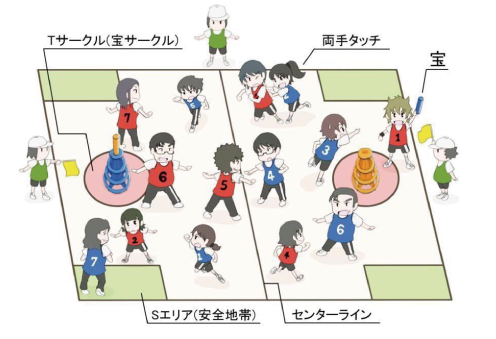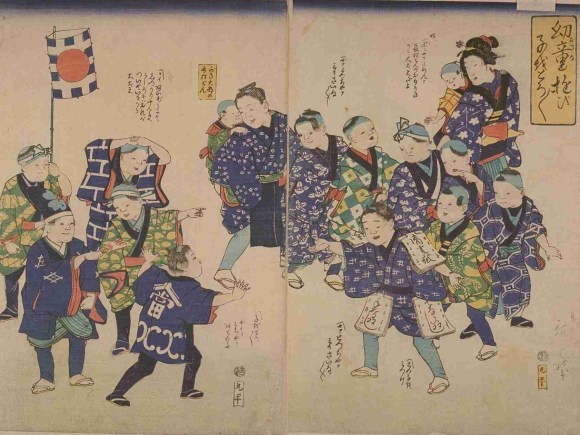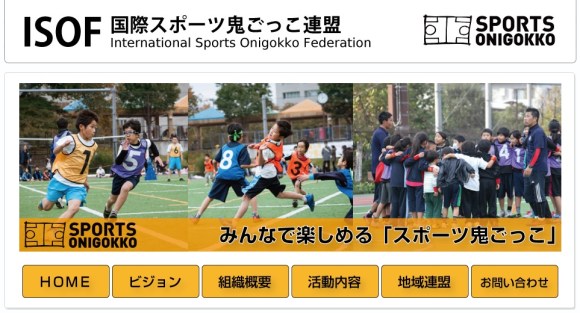
No matter what culture you come from, you have probably played a game of tag or a similar game by a different name at least once in your life. It’s a childhood pastime that quite possibly dates well back into prehistoric times in one form or another.
In Japan it is well-loved and goes by the name onigokko (“play demon”) wherein on player takes the role of the oni (demon/”it”) and tries to touch the other players which will turn them into oni.
I say “well-loved” because in recent years the country has held the largest games of tag in the world and has currently evolved the game into “sports onigokko” an organized team-based version of the of what you may know as tag.
■ For your health!
The modern game of onigoko has been traced back to a game played in the Heian period. Going into the Edo period it took on the name kotorokotoro (“catch kids, catch kids”) and featured three roles: oni, parent, and child. Like onigokko the target is to catch the other players, but in kotorokotoro one of the other players is the parent behind whom all other players (the “children”) must stay behind in single file. Every child the oni touches then becomes and oni and the game ends when all of the children are taken.

While onigokko has evolved into a more individual player’s game since then the International Sports Onigokko Federation (ISOF) has brought a bit of that team spirit back in sports onigokko. It was originally started in the ’80s by Josai University Professor Yasuo Hasaki as a way to combat childhood obesity. The sport is highly competitive so requires a degree of physical activity and exercise, but the method of play requires no special equipment or training.
■ Rules
Sports onigokko is played on a 15m by 25m court with a stand on either end (see the image at the top of this page). The stands have a small cylinder on top which the players must snatch from the opposing team’s side. However, once a player enters that side they can be tagged and forced to return to their own side off-court.
There are also safety zones in the four corners of the court which offensive players can be protected from getting tagged. Tags must be two-handed and of course excessive hitting or other violent contact will not be tolerated. Every time the cylinder is grabbed a point is scored and the team which gets the most points in two five-minute halves is the winner.
■ You’re it Tokyo 2020!
The sport is constantly being reviewed for rule changes and additions to make it more entertaining under the auspices of the ISOF and Inetnational Onigokko Association (IOA). The ISOF is currently headed by Yasuo Hasaki’s son Takao Hasaki who has been hard at work promoting the sport.
Recently it has undergone what some call a “silent boom” where its popularity has increased substantially but without any major media attention. The games inherent inclusiveness and requirements for strategic teamwork and communication has made it a favorite for corporate and community building events. Some have even worked it into a group dating exercise giving you the chance to triumph over some special guy or gal with you tag skills.
All in all, it’s been reported that around 180,000 people have played sports onigokko to date. A national tournament has been established and currently there are plans to expand to an international one by 2016 incorporating some Southeast Asian countries who have taken an interest in it. The next milestone for Hasaki and the rest of the association is clear: a spot as a demonstration sport at the 2020 Tokyo Olympic Games.
Although people’s gut reaction might be to scoff at sports onigokko as a glorified kids game, but really it appears to be sports at its purest. The game has a high emphasis on physical ability and strategy and also leaves very little room for luck in the equation.
Perhaps the Olympic committee will see it that way too and give sports onigokko a shot. We may also have a good chance seeing it at the games if they decide to choose the demonstration sport by rock-paper-scissors or eeny, meeny, miny, moe.
Source: International Onigokko Association, International Sports Onigokko Federation, Yahoo! Japan News, Hachima Kiko (Japanese)
Top Image: IOA
Video: YouTube – International Onigoko Association


 Chiba police looking for man threatening to kill kids who don’t play tag with him
Chiba police looking for man threatening to kill kids who don’t play tag with him Google made a free-to-play ninja cat RPG to celebrate the Tokyo Olympics, and it’s awesome!
Google made a free-to-play ninja cat RPG to celebrate the Tokyo Olympics, and it’s awesome! Tokyo loses 2020 Olympic marathon as IOC shifts race to another part of Japan
Tokyo loses 2020 Olympic marathon as IOC shifts race to another part of Japan Japan Snow Battle Federation looking to make snowball fights Olympic event
Japan Snow Battle Federation looking to make snowball fights Olympic event Naomi Osaka chooses Japanese citizenship over U.S., hopes to represent Japan at Tokyo Olympics
Naomi Osaka chooses Japanese citizenship over U.S., hopes to represent Japan at Tokyo Olympics Majority of Japanese mayors say foreign residents are essential but most see good and bad effects
Majority of Japanese mayors say foreign residents are essential but most see good and bad effects Four Shinto shrines to pray for love at in Japan to start the New Year
Four Shinto shrines to pray for love at in Japan to start the New Year Japanese beef bowl chain Sukiya’s 2026 Smile Box lucky bag basically pays for itself
Japanese beef bowl chain Sukiya’s 2026 Smile Box lucky bag basically pays for itself Mt. Fuji climbing reservation website is now open, and here’s how to reserve your spot
Mt. Fuji climbing reservation website is now open, and here’s how to reserve your spot Creating a cat island – Japanese organization plans to buy island turn it into kitty paradise
Creating a cat island – Japanese organization plans to buy island turn it into kitty paradise Survey finds more than 70 percent of Japanese children have an online friend
Survey finds more than 70 percent of Japanese children have an online friend Blackboard art contest produces entries that will take your breath away
Blackboard art contest produces entries that will take your breath away New Japanese menstrual product seeks to help women spot unidentified iron deficiencies
New Japanese menstrual product seeks to help women spot unidentified iron deficiencies Amazing ukiyo-e art exhibit gives you the chance to step inside a woodblock print and snap photos
Amazing ukiyo-e art exhibit gives you the chance to step inside a woodblock print and snap photos 7-Eleven Japan’s latest spicy curry promises to take our voice away, but does it deliver?
7-Eleven Japan’s latest spicy curry promises to take our voice away, but does it deliver? Starbucks Japan ready to get Year of the Horse started with adorable drinkware and plushies【Pics】
Starbucks Japan ready to get Year of the Horse started with adorable drinkware and plushies【Pics】 Hayao Miyazaki says Happy New Year to Studio Ghibli fans with new art for Year of the Horse
Hayao Miyazaki says Happy New Year to Studio Ghibli fans with new art for Year of the Horse 7 great places to see Mt. Fuji from without having to climb it
7 great places to see Mt. Fuji from without having to climb it We found possibly the quietest Japanese-style hotel in Tokyo’s bustling Shinjuku district
We found possibly the quietest Japanese-style hotel in Tokyo’s bustling Shinjuku district Cup Noodle tries an authentic Jiro-style ramen, but something’s not quite right
Cup Noodle tries an authentic Jiro-style ramen, but something’s not quite right Hello Kitty Choco Egg figures are an adorable trip through three periods of Japanese pop culture【Pics】
Hello Kitty Choco Egg figures are an adorable trip through three periods of Japanese pop culture【Pics】 Japan’s oldest largetooth sawfish in captivity back on display in Mie Prefecture
Japan’s oldest largetooth sawfish in captivity back on display in Mie Prefecture Cyberpunk anime meets traditional culture in Ghost in the Shell gold leaf Japanese changing screens
Cyberpunk anime meets traditional culture in Ghost in the Shell gold leaf Japanese changing screens The best Starbucks Japan Frappuccinos we want to drink again in 2026
The best Starbucks Japan Frappuccinos we want to drink again in 2026 We revisited Sweets Paradise after a decade to see if Japan’s dessert buffet still delivers
We revisited Sweets Paradise after a decade to see if Japan’s dessert buffet still delivers 7-Eleven Japan starts new temporary luggage storage service in over 300 branches
7-Eleven Japan starts new temporary luggage storage service in over 300 branches Disillusionment at Tsukiji’s tourist-target prices led us to a great ramen restaurant in Tokyo
Disillusionment at Tsukiji’s tourist-target prices led us to a great ramen restaurant in Tokyo Starbucks teams up with 166-year-old Kyoto doll maker for Year of the Horse decorations【Photos】
Starbucks teams up with 166-year-old Kyoto doll maker for Year of the Horse decorations【Photos】 Tokyo considering law requiring more trash cans following litter increase in heavily touristed area
Tokyo considering law requiring more trash cans following litter increase in heavily touristed area Tokyo’s Tsukiji sushi neighborhood asks tour groups to stay away for the rest of the month
Tokyo’s Tsukiji sushi neighborhood asks tour groups to stay away for the rest of the month Tokyo event lets you travel back in time, for free, to celebrate 100 years since Showa era start
Tokyo event lets you travel back in time, for free, to celebrate 100 years since Showa era start Sanrio theme park in Japan announces plans to expand into a Sanrio resort
Sanrio theme park in Japan announces plans to expand into a Sanrio resort Japan may add Japanese language proficiency, lifestyle classes to permanent foreign resident requirements
Japan may add Japanese language proficiency, lifestyle classes to permanent foreign resident requirements Stamina-destroying “Paralysis Noodles” are Tokyo’s newest over-the-top ramen innovation
Stamina-destroying “Paralysis Noodles” are Tokyo’s newest over-the-top ramen innovation Survey asks foreign tourists what bothered them in Japan, more than half gave same answer
Survey asks foreign tourists what bothered them in Japan, more than half gave same answer Japan’s human washing machines will go on sale to general public, demos to be held in Tokyo
Japan’s human washing machines will go on sale to general public, demos to be held in Tokyo Japan’s deadliest food claims more victims, but why do people keep eating it for New Year’s?
Japan’s deadliest food claims more victims, but why do people keep eating it for New Year’s? We deeply regret going into this tunnel on our walk in the mountains of Japan
We deeply regret going into this tunnel on our walk in the mountains of Japan Studio Ghibli releases Kodama forest spirits from Princess Mononoke to light up your home
Studio Ghibli releases Kodama forest spirits from Princess Mononoke to light up your home Major Japanese hotel chain says reservations via overseas booking sites may not be valid
Major Japanese hotel chain says reservations via overseas booking sites may not be valid Put sesame oil in your coffee? Japanese maker says it’s the best way to start your day【Taste test】
Put sesame oil in your coffee? Japanese maker says it’s the best way to start your day【Taste test】 No more using real katana for tourism activities, Japan’s National Police Agency says
No more using real katana for tourism activities, Japan’s National Police Agency says Starbucks Japan reveals new sakura drinkware collection, inspired by evening cherry blossoms
Starbucks Japan reveals new sakura drinkware collection, inspired by evening cherry blossoms Updated cherry blossom forecast shows extra-long sakura season for Japan this year
Updated cherry blossom forecast shows extra-long sakura season for Japan this year Pikachu and Super Mario left out of lineup of official spokescharacters for Tokyo Olympics
Pikachu and Super Mario left out of lineup of official spokescharacters for Tokyo Olympics Tokyo Olympics might allow you to take one, and only one, drink with you into sweltering stadiums
Tokyo Olympics might allow you to take one, and only one, drink with you into sweltering stadiums Sayonara, stadium! Tokyo tosses out design for 252 billion-yen Olympic site, starts from scratch
Sayonara, stadium! Tokyo tosses out design for 252 billion-yen Olympic site, starts from scratch Tokyo Olympics will take place as scheduled “with or without COVID” says IOC exec
Tokyo Olympics will take place as scheduled “with or without COVID” says IOC exec Tokyo Olympics announces new start date following coronavirus postponement
Tokyo Olympics announces new start date following coronavirus postponement Nihon? Nippon? What’s the correct name for “Japan” at the Tokyo Olympics (and in general)?
Nihon? Nippon? What’s the correct name for “Japan” at the Tokyo Olympics (and in general)? IOC member says decisions on Tokyo Olympics must be made by late May due to coronavirus fears
IOC member says decisions on Tokyo Olympics must be made by late May due to coronavirus fears Coca-Cola gears up for the Tokyo 2020 Olympics with crazy tall vending machine in Japan
Coca-Cola gears up for the Tokyo 2020 Olympics with crazy tall vending machine in Japan Official Tokyo Olympic volunteer nickname chosen by the public, public doesn’t seem to like it
Official Tokyo Olympic volunteer nickname chosen by the public, public doesn’t seem to like it
Leave a Reply